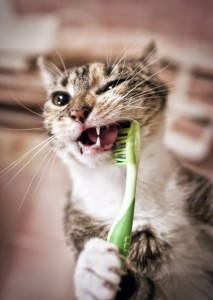 We typically think of cats as being completely self-sufficient and, like today’s ovens, self-cleaning. But have you ever seen a kitty using a toothbrush or dental floss? Cats, just like humans, have bacteria and plaque in their mouths which, if not taken care of, can lead to gum disease, abscessed teeth and tooth loss. However, because they are cats, they need a little help to keep their mouths healthy.
We typically think of cats as being completely self-sufficient and, like today’s ovens, self-cleaning. But have you ever seen a kitty using a toothbrush or dental floss? Cats, just like humans, have bacteria and plaque in their mouths which, if not taken care of, can lead to gum disease, abscessed teeth and tooth loss. However, because they are cats, they need a little help to keep their mouths healthy.
Feline Dental Diseases
According to the Cornell University College of Veterinary Medicine, an estimated 85 percent of cats over the age of 6 have periodontal disease. The next most common dental problem in cats is Feline Odontoclastic Resorptive Lesions (FORL). Lesions, caused by plaque build-up, develop in the bone tissue below the tooth’s enamel. Left untreated, this may cause irreparable damage to the tooth and the root.
Kitty Dental Care
Is it even possible to clean a cat’s teeth? While it’s easier if you begin when they’re a kitten, you can still clean an adult cat’s teeth with a bit of patience and wise tactics. PetMD gives tips on how to care for your cat’s teeth and oral health, as well how to recognize if there’s a problem. If your cat has exceptionally foul breath or is drooling, that may be an indication of tooth decay or gum disease.
Your cat’s yearly trip to the veterinarian should include a thorough oral examination. Tell the vet if they have bad breath or if their mouth is bleeding. This may indicate the need for a professional cleaning or perhaps a tooth extraction.
Home Dental Care for Cats
At home, you should establish a regular cleaning routine for your cat. For a kitten, just as you would for a newborn baby, you can use a piece of soft gauze or a finger cot. Don’t use regular “people toothpaste,” since fluoride and other ingredients can be extremely harmful to your pet, if swallowed. Instead, use toothpaste that is specially made just for cats. The feline-friendly flavors will make tooth brushing a far more pleasant experience for both of you. There are even cat dental kits and kitty toothbrushes available. If you can, massage their gums, since this will stimulate healing and make the gums healthier.
Healthy Foods and Treats for a Cat’s Oral Health
As with humans, diet is very important for a cat’s dental hygiene. A combination of wet and dry foods while varying the meats will keep them healthy and minimize the chance of tooth decay. There are tartar control treats which may help keep your cat’s teeth clean, but they can’t replace regular brushing. As a special treat, give your cat a bone to chew on! Normally we associate bones with dogs, but cats, as natural predators, are accustomed to chewing on hard bones. Chewing on bones helps to knock tartar off teeth, and it keeps their teeth and gums strong and healthy. If you have an indoor cat who doesn’t hunt, this is especially important. Stay away from chicken, fish or pork bones, as these may splinter and cause injuries. Raw bones are less likely to splinter.
If left untreated, gum disease and tooth decay can lead to a serious illness. Stay on top of your cat’s dental hygiene for a purrrfectly healthy mouth!







Leave a Reply